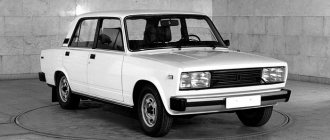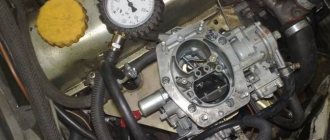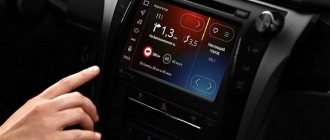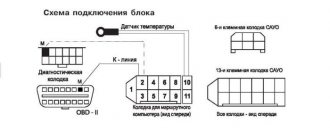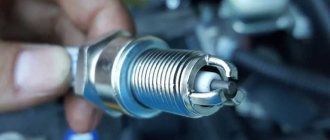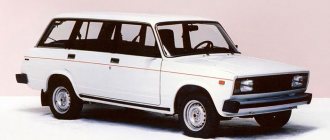By kanistra Posted on 04/23/2015
The VAZ 2106 can easily be called a legend of several eras. The rear-wheel drive model replaced the no less famous 2103, and took its place on the assembly line in 1976. And only in 2006 the “six” were retired. It must be said that the car became a “long-liver” due to its complex of qualities. First of all, we are talking about the efficiency of the engine and the simplicity of repairs. Production of 2106 was carried out in Togliatti for a long time, but by the end of the twentieth century the model began to be assembled in Syzran, and then in Izhevsk.
How to reduce fuel consumption - 10 TIPS
We are talking about principles that excessively increase fuel consumption during operation.
- A dirty air filter impairs the performance of the air supplied to the engine. Naturally, this affects the parameters of the fuel mixture. Such a violation can significantly increase consumption and reduce power. Don't delay replacing the filter.
- A dirty oil filter similarly complicates the operation of the internal combustion engine.
- Insufficient tire pressure will require more fuel. The rolling gets worse. Check your tire pressure regularly.
- Warming up the engine before driving provides minor fuel savings.
- Low quality gasoline, we are talking not only about consumption, but also about additional harmful effects on individual engine components.
- Impaired wheel alignment and camber acts similarly to tires with insufficient pressure, and rolling resistance increases.
- Electric consumers influence fuel consumption. The air conditioner produces the highest consumption.
- Car load. Empty the trunk of “useful” and “necessary” things; at short intervals the difference will not be noticeable, but over the course of a year you will save a dozen or so liters.
- Keep the revs low according to the transmission capabilities
- Air resistance at high speeds; the higher the speed, the more the oncoming air masses hinder the movement of the car.
VAZ 2104
The model, created as a station wagon based on the VAZ 2102, has long been considered the cheapest station wagon among all cars sold on domestic car markets. The popularity of the 2104 lay in the fact that it was assembled from simple parts, and that spare parts for it were always easy to find. The model was produced at the factory from 1984 to 2012. During its production, the VAZ 2104 was equipped with one of four options for gasoline engines or a diesel power unit.
| Engine | Consumption (city) | Consumption (highway) | Flow (mixed) | Type of fuel |
| 1.3 MT 64 hp | 10.0 | 5.8 | 7.4 | Petrol |
| 1.5 MT 75 hp | 10.2 | 7.4 | 9.0 | |
| 1.6 MT 74 hp | 9.5 | 6.8 | 9.2 | |
| 1.7 MT 79 hp | 9.5 | 7.2 | 8.2 | |
| 1.5 MT 50 hp | 5.7 | 5.8 | 5.8 | Diesel |
VAZ-2105 real fuel consumption per 100 km: reviews
With 1.3 engine
- Vitaly, MSK. I have a six made in 1980, an excellent workhorse for everyday use. Ordinary and unpretentious in service, my expensive beauty. Of course, I repair it myself, fortunately I still have my father’s garage with the necessary spare parts. The car does not require qualified repairs; all you need to do is take a manual. And of course, this requires straight hands, certainly not without it. The six is equipped with a 1.3-liter. engine and mechanics that perform the job smoothly like a clock. Typical consumption per hundred kilometers. forms 9 liters, fill with 92.
- Anatoly, Nizhnekamsk. I liked the car and it would be suitable for the role of a first car. I have a 1.3 l. modification, with manual transmission. I took it with a trailer - I'm a big business owner. The car consumes 9-11 liters
- Anatoly, Tver region. The car is a blast, it suits me absolutely - durable and inexpensive to service, I got in and drove off as they say. Consumables and parts are budget, I carry them with me in the trunk - a common thing for a pelvis. Consumption 9 l.
- Arthur, Dnepr. In the end I am satisfied with the machine, a machine for any purpose. If you don’t pick too much, then this is a multifunctional car. In any case, together with the VAZ-2106 it is possible to drive along any roads, even along easy pathless roads. The Shahi's chassis is soft and energy-intensive, and is not afraid of breakdowns and potholes. Roomy trunk and interior, clear controls. Everything is so simple that, it would seem, there is nothing to break here. Alas, there are problems, but I attribute them to being 20 years old. The car consumes 9 liters per hundred kilometers.
VAZ 2101
Under this name, the first Zhiguli model appeared at the Volzhsky Automobile Plant. The VAZ 2101 became a pioneer in the family of the most popular domestic cars, enjoying success both among Soviet drivers and abroad. This car rolled off the factory assembly line in 1970, and production of the “penny” continued until 1988, after which it was replaced by new modifications on the same platform. VAZ 2101 was recognized as “The best domestic car of the 20th century.” Over the entire production period, only one of two engine options was installed on this model: either a 1.2-liter engine with a capacity of 64 hp, or a 1.3-liter power unit with 69 “horses”. Both engines were accompanied by a four-speed manual transmission.
| Engine | Consumption (city) | Consumption (highway) | Flow (mixed) | Type of fuel |
| 1.2 MT 64 hp | 9.4 | 6.8 | 8.0 | Petrol |
| 1.3 MT 69 hp | 9.4 | 6.8 | 8.0 |
Practical recommendations
Fuel consumption is affected by:
- technical condition of the machine;
- operating features.
In order to achieve more economical consumption, it is necessary to promptly clean and replace certain components of the mechanism.
In particular, an increase in the amount of gasoline or gas consumed is often a sign that the engine has almost exhausted its resource.
Wear of the cylinder-piston increases the gaps between the cylinder walls and the rings. Because of this, exhaust gases and the fuel-air mixture enter the piston space. For the same reason, compression in the cylinders drops. The warm air mixture cannot burn completely. Therefore, part of the mixture remains unused and simply flies out through the exhaust pipe. Engine wear affects its functioning. Because of this, the car accelerates poorly. The driver has to press the pedal harder to accelerate the car. Taking all this into account, it is not difficult to conclude that in order to reduce gasoline or gas consumption, you must first diagnose the engine. You need to measure the compression, listen to whether the engine makes any unusual noises during operation. If worn components are found, they must be replaced.
Also, the consumption of gasoline or gas depends on the condition of the gas distribution mechanism. If carbon deposits that form on valve seats and edges are not promptly removed, this will lead to loss of compression due to a loose fit.
Cleaning the valves and, if necessary, repairing the cylinder head will significantly reduce gasoline/gas costs. It is important to promptly diagnose the gas distribution mechanism and promptly replace worn parts.
Fuel consumption also depends on the carburetor. If you install a contactless ignition system and a Solex carburetor, then this combination will reduce the amount of gasoline or gas consumed. It is very important to adjust the carburetor correctly. It will be possible to reduce consumption by installing jets with a reduced cross-section. However, this will lead to a decrease in the dynamics and power of the machine. After this adjustment you will have to forget about overtaking. It will be very difficult to accelerate such a car. Therefore, it is better to carry out adjustments without replacing the jets. It is necessary to adjust the carburetor in such a way as to achieve a “golden mean” between power and fuel consumption. If the carburetor is clogged and incorrectly adjusted, fuel dosing is disrupted. Therefore, regularly check the condition of the carburetor and wash it periodically.
VAZ 2113
The production of this three-door hatchback, which contains basic elements of the VAZ 2108 and VAZ 2115, began in 2004 and was produced until 2014, being removed from the assembly line only after the appearance of more modern models. The cars of this series were equipped with gasoline engines with fuel injection, which worked in conjunction with a five-speed manual transmission.
| Engine | Consumption (city) | Consumption (highway) | Flow (mixed) | Type of fuel |
| 1.5 MT 79 hp | 9.2 | 7.6 | 8.4 | Petrol |
| 1.6 MT 81 hp | 10.0 | 5.7 | 7.6 | |
| 1.6 MT 98 hp | 9.8 | 5.2 | 7.4 |
VAZ 2111
This model is a modification of the “ten” with a station wagon body. At the Togliatti plant, such cars were assembled from 1998 to 2009, and at several subsidiaries, production of the VAZ 2111 continued until 2014. The main power unit on this car has always been a 1.5-liter engine with different power ratings, depending on the number of valves. Some buyers were more impressed by options with a 1.6-liter engine. On cars with an engine capacity of 1.7 and 1.8 liters, all-wheel drive was installed, while smaller displacement cars were equipped with only front-wheel drive.
| Engine | Consumption (city) | Consumption (highway) | Flow (mixed) | Type of fuel |
| 1.5 MT 72 hp | 9.0 | 7.5 | 8.2 | Petrol |
| 1.5 MT 79 hp | 10 | 5.7 | 7.2 | |
| 1.5 MT 92 hp | 8.8 | 5.6 | 7.6 | |
| 1.5 MT 94 hp | 9.0 | 7.5 | 8.2 | |
| 1.6 MT 81 hp | 9.0 | 5.6 | 7.5 | |
| 1.6 MT 89 hp | 9.0 | 7.5 | 8.2 | |
| 1.6 MT 90 hp | 10.0 | 5.8 | 7.3 | |
| 1.7 MT 90 hp 4x4 | 11.8 | 9.5 | 10.2 | |
| 1.8 MT 98 hp 4x4 | 11.8 | 9.5 | 10.2 |
Owner reviews
“I got the car from my father. I had to tinker with it a little to bring it into a more or less modern look, but I didn’t touch one thing at all. This is the engine. It worked flawlessly in the first days after acquisition, and it still works today. The car does not shine with its appearance, interior comfort and other things, but for use as a workhorse this is just the thing. The main thing is to look after and monitor it, then the car will last for many, many years. Of course, I won’t be able to drive it, and I don’t need to. Now I’m just learning and gaining experience, so it’s quite enough for me. Its gasoline consumption corresponds to the passport data and does not exceed 8 liters,” writes Vladislav from Novgorod.
“I was looking for a car that I wouldn’t mind killing, because I just got my license and needed experience. I've been driving it for a year now and haven't broken anything yet; I can't even damage it. It is impossible to judge the car objectively, since it is very old and neither the design nor the interior correspond to modern concepts of beauty and comfort. Basically, all there is is a stove, but it works well. When you are driving along the highway, you should never let go of the steering wheel, as the car immediately begins to pull to the side. One thing is for sure that the car is assembled with high quality, for many years to come. However, my car has increased consumption, which is as much as 12 liters in the city and 9 on the highway,” says Alexey from St. Petersburg about his car.
And this is Vladimir’s review from Kazan:
“I bought a car second-hand to use it as a taxi driver. I was very lucky because the previous owner took care of her as best he could. I myself have been driving for several years and also keep it in good condition, fortunately this is not difficult to do, since if something breaks, it can be easily fixed even without contacting a service center. Of course, one can only dream of the comfort of modern cars here; everything is controlled exclusively by the driver, with a minimum of electronics. But there is more than enough reliability. The engine has never let me down, although I have never been in any situations. But it has high fuel consumption, which for me is 10 liters.”
This review was left by Valery from Ufa:
“This is one of the first cars I owned; I bought it back in 1976. During this time I have already driven about half a million kilometers. Wherever the car was, I drove it almost all over Russia. And I never broke down or stalled, it always works like a clock. Yes, over time, such design forms have gone out of fashion, the interior equipment has remained a thing of the past, but I will not sell it. I take care of her as best I can. Fortunately, finding all the details is not a problem at all. I like that both at the beginning of use and now there is the same fuel consumption, namely 8 liters.”
“I bought the car in the early 90s. During all the time of use, I never looked into the engine, as there was no need, because everything works efficiently and reliably. The car is ideal for trips to the country. It’s a pity that the interior equipment is a bit old for our time; in the summer it’s very difficult without air conditioning, but you can endure it by opening the window. But in winter it is very warm, since the stove is just fire. I also actively monitor the appearance; I recently painted and replaced the bumpers. As for consumption, everything is clear, as it is written in the passport - no more than 9 liters in the city and 7.5 on the highway,” reports Nikolay from Perm.
“I think this model is the best for use on our roads. Of course, all the holes near the bumps are perfectly felt, but all this does not cause any damage to the car, since, it feels like, the body and all technical elements are made of titanium. It is simply impossible to break anything here. The motor is also highly reliable, which in 15 years of use I have never really seen. The only downside here is the interior equipment, which has none of the functions that make life easier for the driver. But the car consumes little gasoline, only 8 liters,” writes Grigory from Kursk.
Technical characteristics of Lada
If we talk specifically about the VAZ 2106, then this car fully corresponds to its price category, it is equipped with everything necessary, and has an attractive design.
The VAZ 2106's gasoline consumption per 100 km is low, about 7 liters on the highway, and about 10 liters in the city
. This is normal consumption for a car with such power, but it is worth noting that such fuel consumption of 2106 per 100 km is beyond the means of many car enthusiasts.
To avoid problems with servicing your VAZ 2106, you should pay attention to some things even when purchasing it:
- The price of the car itself;
- The approximate price you are willing to spend on its maintenance per year;
- Approximate cost of gasoline for a car per month;
- Unplanned capital investments;
Only by calculating the approximate costs of it for a year, and correlating it with your capabilities, can you determine your chances of properly servicing such a car.
Fuel consumption on a carburetor VAZ 2106 also does not exceed the norm, and is not particularly different from the usual consumption of this VAZ, because the volume of gasoline burned can fluctuate, depending on many factors: weather conditions, the condition of the car, driving habits, the quality of gasoline and oil.
Only after consulting with them, you will be able to make the right decision, or, perhaps, you will be insured against unpleasant situations and possible breakdowns.
VAZ 21099
This model is perhaps the most popular sedan in the CIS countries. Its production began in 1990 and successfully continued until 2004. The VAZ 21099 was assembled in Ukrainian factories until 2011. The car differed from its predecessors in the presence of a dashboard, additional body kits and interior trim. Depending on the year of manufacture, the car could have one of five types of engines. Modifications of 1.3-liter power units were accompanied by a carburetor fuel supply, and on 1.5-liter versions either a carburetor or an injector was installed. All models had a five-speed manual transmission.
| Engine | Consumption (city) | Consumption (highway) | Flow (mixed) | Type of fuel |
| 1.3 MT 64 hp | 9.1 | 5.8 | 7.7 | Petrol |
| 1.3 MT 135 hp | 12.5 | 7.0 | 10.0 | |
| 1.5 MT 70 hp | 9.1 | 5.7 | 7.7 | |
| 1.5 MT 78 hp | 8.8 | 5.3 | 7.3 | |
| 1.6 MT 81 hp | 9.0 | 5.8 | 7.8 |
VAZ 2131
This car is better known as Niva 2131. Initially, such cars, built on the basis of the Niva 2121, but with a longer body, were intended for export. But due to their good cross-country ability and relatively low price, they have gained popularity in the domestic market. Production of the VAZ 2131 started in 1993 and continued until 2016, when it was replaced by a newer version, the Lada 4×4 Urban. The VAZ 2131 was equipped with one of five gasoline engines or a diesel power unit.
| Engine | Consumption (city) | Consumption (highway) | Flow (mixed) | Type of fuel |
| 1.7 MT 79 hp | 13.7 | 9.8 | 12.0 | Petrol |
| 1.7 MT 80 hp | 13.7 | 9.8 | 12.0 | |
| 1.7 MT 83 hp | 13.7 | 9.8 | 12.0 | |
| 1.8 MT 82 hp | 13.8 | 12.0 | 13.2 | |
| 1.8 MT 84 hp | 13.8 | 12.0 | 13.2 | |
| 1.9 MT 50 hp | 9.7 | 6.8 | 7.6 | Diesel |
The actual fuel consumption of VAZ models per 100 km may differ from the standard data specified in the tables, and it can only be determined experimentally. It is important to remember that average fuel consumption can differ significantly in winter and summer. If fuel consumption is much higher than the average values given in the tables, the car must be taken to a mechanic service station and, after determining all the factors of increased consumption, it may be worth switching it to gas.

